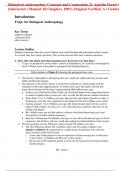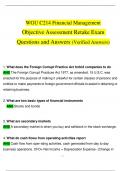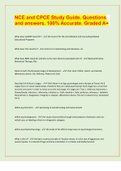IM – intro | i Introduction FAQs for Biological Anthropology Key Terms adaptive radiation continental drift plate tectonics Lecture Outline Students sometimes take this course without some useful background information about science. As a result, they have many questions. This section answers their most common questions. A. How old is the planet and what organisms have lived on it over that time?
1. To give us perspective on the relative context of humankind, let’s quickly run through the
last 4.5 billion years of the planet’s geological and biological history.
Refer students to Figure I.1 showing the geological time scale. 2. The history of this planet is divided up into eras, which are subdivided into periods, and
further divided into epochs .
3. The majority of the earth’s history is in the Pre -Cambrian era, which began with the
formation of the earth (approximately 4.5 billion years ago) and ended with the first
major diversification of life forms (approximately 600 million years ago).
•In this era we find the first hints of life, tiny fossilized impressions suggesting clusters
or chains of linked cells ( prokaryotic cells, or cells that that do not contain a nucleus) .
•From about 3.5 to 1.5 billion years ago, these are the only kinds of fossils we find, so
Prokaryotes were the only organisms on the planet for the first 2 billion years of life.
•Starting around 1.5 to1.2 billion years ago, life forms became more diverse, and we
begin to find evidence of eukaryotic cells (cells that have a nucleus, like those of all
animals and plants).
•By 1 billion years ago we find indirect evidence (fossilized burrowing tracks and
fecal pellets) of multi -cellular organisms.
•Between 1 billion and 570 million years ago we see a diversification of types of fossil
organisms, but all life is still very small and confined to limited habitats in the oceans.
4. The next geologic era, the Paleozoic, began around 570 million years ago.
•The first Paleozoic period, the Cambrian, shows the first major example of an
adaptive radiation (the expansion by a single group of organisms into a diverse
array of forms) in the fossil record.
oAt the start of this period we see an explosion of forms moving into a wide array
of new niches, or habitats and lifeways, in the oceans.
oBy the end of the Cambrian period we have the first precursors for many modern
animal lineages.Biological Anthropology Concepts and Connections 2e Agustin Fuentes (Instructor's Manual All Chapters, 100% Original Verified, A+ Grade) IM – intro | ii •Throughout the rest of the Paleozoic we see an array of new forms arising from
existing varieties.
oIn the Ordovician, we see a great expansion in complex multicellular organisms
including the first fishes (jawless fishes).
oBy the beginning of the Silurian we find fossils of jawed fishes, which suggests a
radical change in the cycle of life. These are the first active vertebrate predators.
These earliest jawed fish have no bones, only cartilage, and at least one lineage of
these early Silurian fish is ancestral to modern sharks and rays.
oBy the mid -Silurian, bony fish show up in the fossil record and diversify into at
least two main groups: the lobe -finned and the ra y-finned fishes. The currently
favored hypothesis is that one or more lineages of lobe -finned fishes gave rise to
the first land vertebrates (the amphibians). The first fossils of land plants show up
during this period.
oBy the end of the Silurian we have evidence of land animals (insects), complex
land plant formations (like swamps), and a huge array of life forms in the seas.
oFrom the rest of the Paleozoic we find a growing number of fossils of land
animals, especially in coastal areas, where the early amphibians (which looked
very much like slightly modified lobe -finned fish), gradually changed into a wide
array of amphibian forms and early reptiles.
oDuring the last period of the Paleozoic (the Permian), there was a broad radiation
of reptilian forms, including a group called the therapsids (mammal -like reptiles),
the reptile group to which mammals are hypothesized to be most closely related.
5. The Mesozoic era began around 225 million years ago.
•By the early Mesozoic, reptiles had undergone a broad and dramatic adaptive
radiation, having been freed from the water by two crucial adaptations —self-
contained eggs and skin that resisted drying out. Reptiles spread across the land
environments and adapted to a broad spectrum of habitats.
•During this era the best known reptile group, the dinosaurs, made up a large portion
of the fossil remains.
•It is also during the Mesozoic that the first mammals appear. These mostly small,
probably nocturnal, insectivorous mammals are found throughout the era, but do not
make their grand adaptive radiation until the Cenozoic.
•While the Mesozoic was the age of reptiles, the Cenozoic (which began around 65
million years ago) was truly the age of the mammals and birds.
•After an enormous extinction event at the Mesozoic -Cenozoic boundary, mammals
and birds began to diversify, filling many of the niches left vacant by the extinctions.
B. If life on our planet has changed so much over time, what about the planet itself?
1. During the time that life on earth has been changing, so has the surface of the planet.
2. The process of plate tectonics drives the phenomena of continental drift .
Refer students to Figure I.3 , a model of the earth’s interior, showing the layers. •Plate tectonics result from the continental plates floating on a layer of mantle
(magma, molten rock, like lava).
•Currents in the magma move the plates in a number of different ways: IM – intro | iii oMagma can push up between plates and solidify, pushing them apart (spreading).
oWhen plates meet, one can overlap and drive the other down into the magma
(subduction).
oPlates can move against one another, pushing the earth up and creating mountain
ranges (collision).
•Continental movement (continental drift) over just the last 200 million years has
dramatically changed the earth’s surface over time.
Refer students to Figure I.4 showing continental drift. •Understanding that the earth and life on it have changed over the last four and a half
billion years is an important basic concept. Students will notice throughout this book
that the notion of change over time is very important for biological anthropology.
C. Have humans changed?
1. Change over time in humans is pretty much the core of biological anthropology.
2. This book will examine the history of humans and their immediate ancestors over the last
five million years.
3. While there are trends and patterns evident in the history of human evolution, there is not
an inevitable trajectory. Knowing this may help students realize that our species is just
one of many on this planet that evolved by filling (and modifying) a specific niche.
Refer students to Figure I.5 showing a timeline of human history. D. Where did modern science come from?
1. What we call modern science developed over the last five or six centuries and is largely a
collaboration between two methodologies:
•inductive (drawing conclusions from extant facts), and
•experimental (testing hypotheses and making observations).
2. This contrasts with the a priori methods used before this time, wherein thinkers went
from cause to effect, basing their reasoning on beliefs or assumptions rather than
experience or testable observations.
•The real hallmark of modern scientific knowledge is its falsifiability , not its
verifiability. Science can prove things 100% false but not 100% true.
•To be falsifiable, statements must be capable of being subjected to tests that might
result in their refutation.
3. Scientific information emerges from series of observations, refutations, and hypotheses
supported by rigorous testing.
4. It is important to realize that all out current knowledge rests on past discoveries and
collaborations.
5. Modern science comes from a specific set of methodologies and a continuous history of
investigation, collaboration and refutation.
6. Understanding that our knowledge is based on prior knowledge, and is subject to change,
is important for assessing the information presented in this text. IM – intro | iv E. Where is Uzbekistan? 1. A major piece of any college student’s baseline education (regardless of your major) is a grasp of the geography of the planet. 2. You are one of over six billion humans currently residing on earth. 3. As a citizen of this planet, you need to know where you and your neighbors live. 4. In this course you will be learning about discoveries that have taken place all over the world. Refer students to Figure I.6 showing a current world map.







